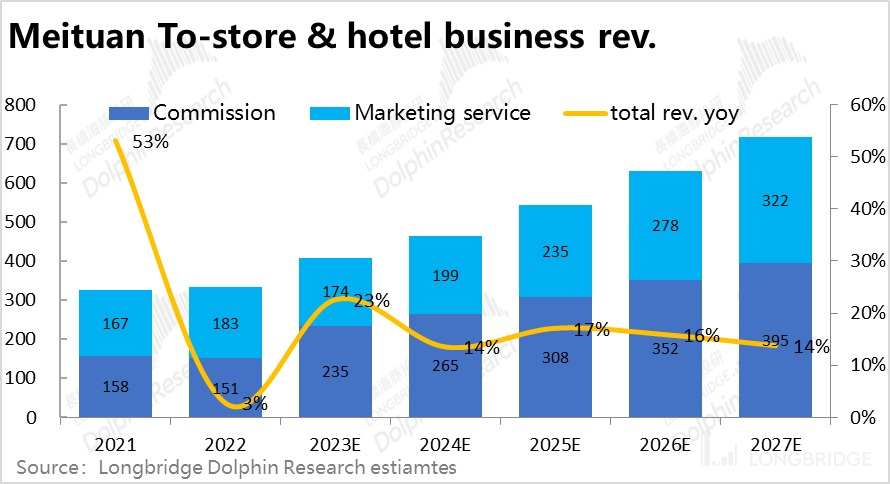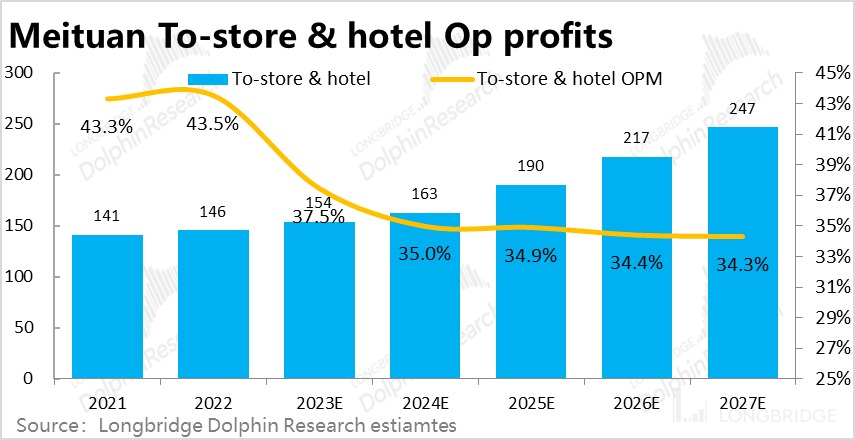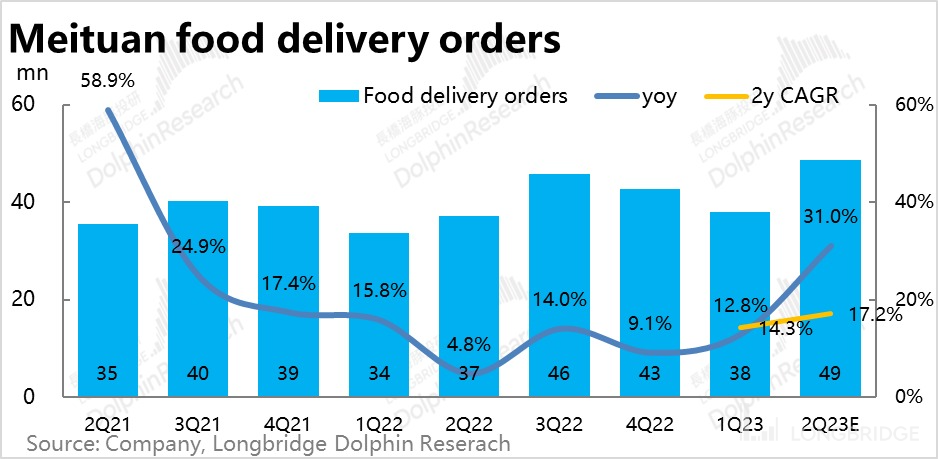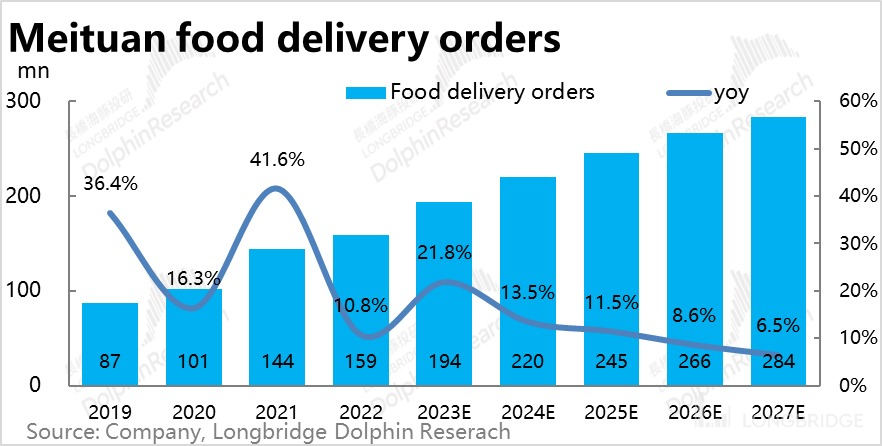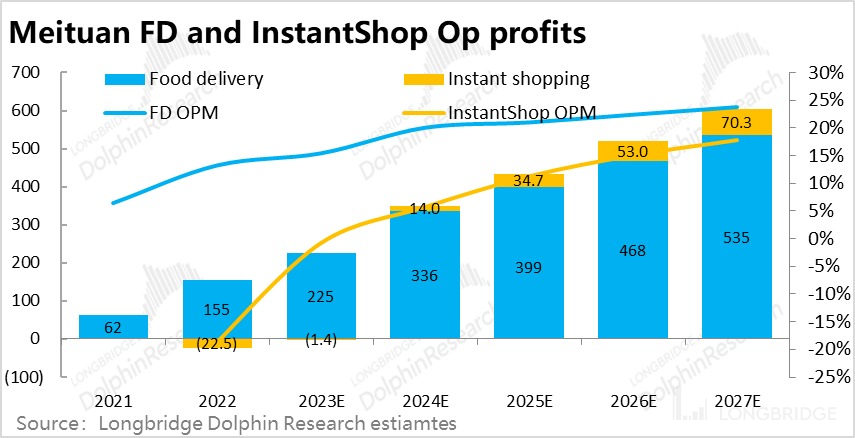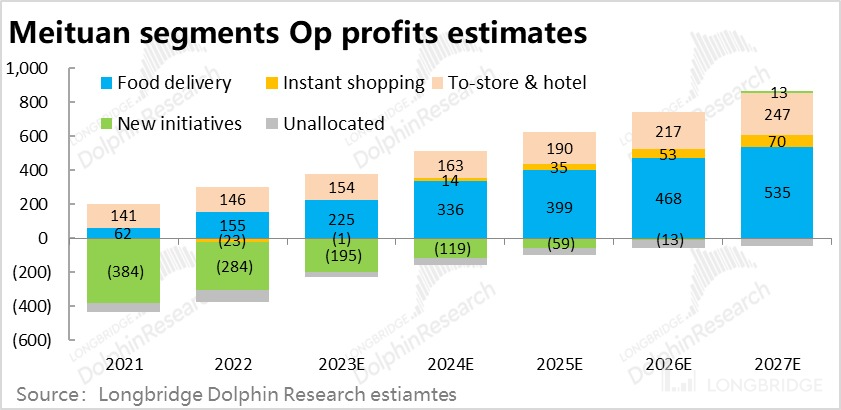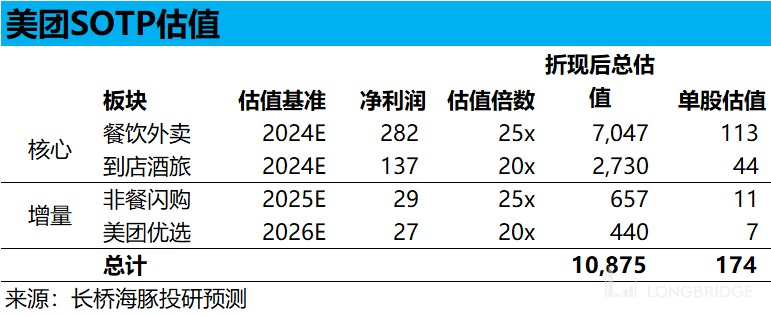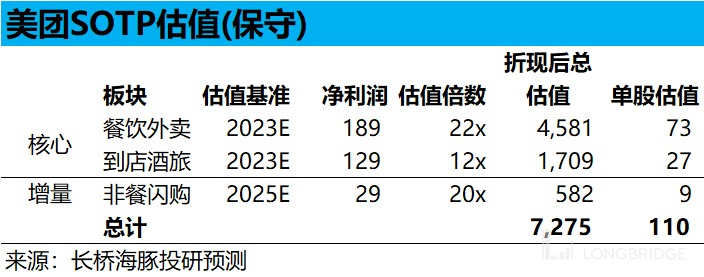
 Likes Received
Likes Received Posts
PostsFaced with ByteDance, MEITUAN-W can't make the same mistake as Alibaba.

Since the release of Dolphin's analysis of MEITUAN-W in late 22, "Finally Released, Can MEITUAN-W Return to the King?" to now less than half a year, the market's belief in MEITUAN-W's "growth and competitive barriers" has further loosened. After the first quarter's profit report exceeded expectations, the stock price instead fell to near the lows of March and October 22.
Therefore, it is time to re-examine the value of MEITUAN-W, whether it belongs to the "golden pit" or the "low-price trap" after a deep correction in the stock price. First of all, we believe that the core issue driving the downward shift of MEITUAN-W's valuation center and the market relationship includes:
(1) In terms of in-store business, concerns about the impact of ByteDance's competition have further fermented and have been verified by two quarters of performance. How big is the erosion from ByteDance? How will the subsequent market competition pattern evolve?
(2) The core valuation of the takeaway business has weak growth after being released. Can it achieve Dolphin's and the market's expectations for steady-state order volume and average profit per order? In addition, although ByteDance, Kuaishou, and others have not yet truly exerted their strength in the takeaway business, will the subsequent competition also deteriorate?
So, regarding the two issues of (1) and (2), Dolphin's viewpoint is:
(1) For the in-store business, from the performance of the past three quarters, the gap between the growth rate of advertising revenue and the commission growth has gradually expanded from 14pct to 22pct, which is obviously lower than the growth rate of GTV. At the same time, the company's guidance for the OPM of in-store business will drop from 48% in the second quarter to 30%. In the industry's recovery, the revenue and profit indicators of the in-store business have both significantly deteriorated (trend), indicating that ByteDance's erosion of MEITUAN-W in the in-store business (especially advertising) is quite serious.
Looking ahead to the subsequent competition pattern, by 2023, ByteDance's verified GTV after the fact may reach 1/4 of MEITUAN-W's, and before verification, it may be close to 1/2. The impact on market share is not better than the situation where ByteDance's e-commerce GMV accounts for 1/3-1/4 of Alibaba's.
At the same time, although research shows that current small and medium-sized merchants are difficult to survive on ByteDance and are beginning to return to MEITUAN-W, local high-efficiency, short-radius specialty stores, combined with ByteDance's strong planting and weak transaction characteristics, serve customers who already have brand promotion needs and cover a wide range of top chain brands.
While the top merchants that ByteDance mainly seizes may account for a minority in terms of quantity, their proportion in the overall advertising market may be a majority. Even if MEITUAN-W still occupies the majority of GTV in the future, the situation of MEITUAN-W's loss of advertising revenue will be worse than that shown by GTV data (similar to the situation where Alibaba's CMR revenue decline rate is faster than GMV). **
Therefore, Dolphin believes that we should fully anticipate the impact of ByteDance's competition on MEITUAN-W, based on which we have significantly lowered the advertising revenue and profit margin of MEITUAN-W's in-store business.
(2) For the takeaway business, excluding the fluctuating base effect in 2022, the 2-year CAGR growth center of takeaway orders in Q1-Q2 of 2023 is around 15-16% (with a less affected March order growth rate of 20%). Based on this center, we estimate that MEITUAN-W's daily takeaway orders are expected to reach 73 million in 2026, which is not much different from Dolphin's previous estimate. However, there is considerable pressure to achieve 80-90 million orders by 2025.
Regarding average profit per order, Dolphin previously predicted that the steady-state profit per order is expected to reach RMB 2 around 2026. In fact, due to the favorable growth in the number of delivery personnel in Q1 this year, the average profit per order for takeaway has reached RMB 1.3. The pace of improvement is even faster than originally expected.
However, for the long-term profit ceiling, Dolphin believes that the potential competition from rivals ByteDance, Kuaishou, and existing Ele.me will limit MEITUAN-W's space to reduce user subsidies. If MEITUAN-W relies too much on its leading position and reduces subsidies excessively or increases monetization rates, it may accelerate the entry of competitors by leveraging their cost-effectiveness advantages. (Similar to the competition process between Alibaba and PDD).
Based on this, Dolphin has lowered its expected average profit per order for takeaway and flash purchase businesses to RMB 1.8 and RMB 1.6, respectively, by 2026.
(3) Based on the above judgments, the estimated valuation range of MEITUAN-W is calculated as follows:
I. How far has ByteDance's erosion of MEITUAN-W's in-store business gone?
1. The situation reflected in MEITUAN-W's financial report is not optimistic
First, let's look at the most worrying and dragging factor on MEITUAN-W's valuation, the in-store business segment. The following chart is the most noteworthy chart in MEITUAN-W's recent financial report. It can be seen that since 3Q 2022, the growth rate of commission income reflecting MEITUAN-W's transaction facilitation ability and advertising revenue reflecting information promotion and distribution in the local life segment has gradually changed from basically the same frequency to commission growth significantly faster than advertising revenue, and the lead margin has gradually expanded by 14pct, 18pct, and 22pct each quarter, and the growth rate difference is gradually expanding.

However, management has previously stated in communications that the advertising monetization rate for the takeaway and flash purchase businesses has actually increased, and the GTV of the in-store hotel and travel business in Q1 has actually increased by a mid-double-digit percentage year-on-year. Therefore, it can be concluded that **ByteDance has significantly eroded the advertising share of in-store merchants on the local life platform. Causing the basic GTV of MEITUAN-W's in-store transactions and advertising revenue to remain stagnant.
In fact, according to management's statement, the overall revenue of in-store travel in the first quarter increased by about 23%, mainly driven by the hot demand for hotel business (up more than 50% year-on-year), and the overall revenue growth rate of in-store business was less than 16%. According to Dolphin's estimation, after excluding commission income, the advertising revenue of in-store business may even have negative growth.
Combined with the company's guidance, due to countermeasures such as subsidies and buying traffic, the overall OPM of the in-store travel sector will drop sharply from 48% in the first quarter to just over 30% in the second quarter. (Although management may intentionally lower market expectations)
Taking a comprehensive look, against the backdrop of a strong rebound in offline consumption in Q1-Q2 2023, the revenue and profit indicators of in-store business have both shown a significant trend of deterioration, so from the achieved performance, ByteDance's erosion of MEITUAN-W in in-store business (especially in advertising) is quite serious.
- From a business model perspective, how much impact will ByteDance have on MEITUAN-W in the future?
Looking beyond financial data, from a business perspective, how much impact will ByteDance have on MEITUAN-W in in-store business in the future? Will it be as serious as ByteDance's "defeat" of Alibaba?
According to recent expert research, ByteDance's pre-verification GTV from January to April this year has exceeded 60 billion yuan, while the full-year target for 2022 is only 70-80 billion yuan. Based on the current trend, achieving a target of about 200 billion yuan for the year should not be a problem. If this is achieved, according to Dolphin's estimation, ByteDance's in-store travel GTV will reach about half of MEITUAN-W's, or about a quarter of MEITUAN-W's if calculated after verification. This is similar to the situation where ByteDance's e-commerce target GMV is about one-third to one-fourth of Taotian GMV. Therefore, from the perspective of GTV, ByteDance's impact on MEITUAN-W in in-store business may be no less than ByteDance's impact on Alibaba in e-commerce.
However, expert research also feedbacked that the month-on-month growth momentum of ByteDance's in-store GTV has begun to slow down since May. The reason is that ByteDance has encountered significant resistance in penetrating small and medium-sized merchants. Due to the short video model's traffic-oriented and winner-takes-all mode, small and medium-sized merchants with less promotion investment find it difficult to obtain traffic and exposure, and ultimately convert to transactions. Therefore, many small and medium-sized merchants, after briefly trying ByteDance, have begun to return to the MEITUAN-W platform, which has a dominant position in transactions.
In fact, in the previous analysis of MEITUAN-W by Dolphin, it was pointed out that local life consumption has the characteristics of relatively high timeliness and short radius, and ByteDance has a strong tendency to plant grass but weak in transactions. ByteDance's target users are large chain merchants with high demand for brand promotion and wide coverage. According to expert research, SKA and KA are also the main users currently served by ByteDance.
Therefore, similar to "video e-commerce vs. price e-commerce", the final outcome of ByteDance's grass-planting strategy vs. MEITUAN-W's transaction-based model is likely to be that ByteDance will only occupy a small part of the market with a smaller GTV, while the MEITUAN-W model will remain mainstream. The final GTV market share pattern may be 3:7 or 4:6 (assuming that ByteDance does not vigorously develop the shelf model).
However, whether MEITUAN-W can hold onto most of the GTV share is uncertain. For example, although ByteDance's e-commerce scale slightly exceeds one trillion GMV, it is far smaller than the 7-8 trillion scale of Taotian. However, Alibaba's core CMR revenue deterioration has always been much higher than the decline in GMV.
In addition, the head merchants that ByteDance mainly targets, who account for a small absolute number, will have a significantly higher proportion in the local life advertising market. Therefore, the situation of MEITUAN-W losing advertising revenue may be worse than what the GTV data shows.
Overall, Dolphin believes that we should fully recognize the impact of MEITUAN-W on the in-store business and not reuse the "mistake" of blindly trusting Alibaba's absolute leading position and barriers to entry on MEITUAN-W.
Therefore, based on the expectation that the GTV ratio of ByteDance and MEITUAN-W is 4:6 and the expected trend of the decline in MEITUAN-W's marketing advertising monetization rate, Dolphin is conservative and expects that the growth of in-store advertising revenue will be significantly slower than commission revenue, and the overall growth rate of in-store revenue will slow down to around 15% after a rebound in 2023.
As for the operating profit margin of the sector, considering the long-term competition, it is expected to decrease to 35% by 2024 according to the company's guidance, and then remain relatively stable.
Second, the core issue of the market is still how high MEITUAN-W can raise its steady-state order volume and average profit per order in the takeaway business, which is currently not a major concern due to the instant delivery barrier. ByteDance's main scenario for takeaway is group meals, which has less overlap with MEITUAN-W's takeaway business. First of all, in terms of year-on-year growth in order volume, according to financial reports and guidance, MEITUAN-W's order volume growth in Q1-Q2 this year was around 13% and 30%, respectively. Excluding the fluctuating base effect in 2022, the 2-year CAGR growth center is around 15-16%. Objectively speaking, this growth center is sufficient to achieve Dolphin's target of more than 70 million daily orders calculated based on the total number of target users for takeaway. However, for investors who expect the daily order volume to reach 80-90 million by 2025, the performance of the past two quarters is not very optimistic.

Looking ahead to the next few years, based on the current 15-16% growth center, Dolphin estimates that the daily order volume for takeaway in 2026 can reach 73 million orders with a slow decline in growth rate in the following years. This estimate is not far from Dolphin's previous estimate.

In terms of average profit per order, Dolphin previously predicted that the steady-state profit would be much higher than the company's earlier guidance of 1 yuan, and is expected to reach an average of 2 yuan per order around 2026. According to the company's recent communication, under the favorable condition of a significant increase in the supply of takeaway delivery drivers in the first quarter of this year, the average profit per takeaway order has reached 1.3 yuan. The pace of profit improvement is faster than Dolphin's original expectations.
However, Dolphin believes that the competition pressure from existing competitors such as Ele.me and potential competitors ByteDance and Kuaishou will limit MEITUAN-W's space to reduce user subsidies in the long term. Although ByteDance and Kuaishou have not seriously entered the takeaway business yet, if MEITUAN-W relies too much on its leading position and reduces subsidies excessively or increases monetization rates, it may accelerate the entry of competitors with cost-effective advantages. (Similar to the competition process between Alibaba and PDD)
Therefore, Dolphin has lowered its expectations for average profit per order, and compared to 2023, the space for increasing average profit per order in the future mainly comes from reducing the loss of 0.4 yuan per order in 1P delivery, while the additional profit brought by increasing monetization rates and reducing subsidies has been lowered to only 0.2 yuan.
Regarding the flash purchase business, Dolphin agrees with the management's claim that the average profit per order and elasticity of flash purchase are not inferior to, or even higher than, takeaway. (The main reason is that the ceiling of the average customer price for flash purchase is significantly higher, as detailed in Dolphin's previous report), but similar to takeaway, the expectation for the average profit per flash purchase order in 2026 has been lowered from 1.8 yuan to 1.6 yuan, while the long-term order volume expectation remains at around 10 million orders. Based on the expected single volume and single average profit mentioned above, Dolphin has calculated the operating profit of takeout and flash purchase business as follows. The flash purchase business began to contribute positive profits from 2024, while the operating profit of takeout business doubled relative to 2023 in 2026.
In general, Dolphin mainly lowered the expected advertising revenue and operating profit margin of the in-store business this time, and also slightly lowered the long-term space of the single average profit of takeout and flash purchase business, but accelerated the pace of improvement.
After the adjustment, Dolphin's current expected operating profit rate to 2025 will reach about 52 billion yuan, which is more than three times that of 2023.
However, although there are concerns about the fundamentals, the current market pricing of MEITUAN-W is still too pessimistic. Based on Dolphin's profit forecast above, according to the DCF model, the neutral valuation of MEITUAN-W is about HKD 160.6, which has about 32% upside and downside compared to today's closing price. For MEITUAN-W, DCF is a relatively neutral valuation method, as it will include hundreds of billions of losses from new businesses in the next few years.
In a relatively optimistic valuation method, we use the SOTP method to value the flash purchase and grocery shopping businesses that are still losing money according to their long-term profitability. Among them, the first and solid barrier of takeout and flash purchase in the industry is valued at 25x PE, and the in-store and grocery shopping business is valued at 20x PE due to competition issues. The more optimistic valuation of MEITUAN-W is estimated to be HKD 174.
In a relatively conservative valuation method, or using the SOTP method, we only consider the core takeout flash purchase and in-store hotel business, and the valuation of takeout business is lowered to 20x-22x, and the PE valuation of in-store hotel is lowered to only 12x due to poor competition prospects. The conservative valuation under this calculation is about HKD 110.

Under the most pessimistic expectations, without splitting up businesses, removing loss-making businesses, or considering the growth space of subsequent performance, the company's valuation can be calculated to be approximately RMB 480 billion, equivalent to HKD 85 per share, based on the expected net profit of RMB 30 billion in 2024 multiplied by an extremely conservative 16x PE valuation. This is a bottom that will not fall no matter what.
Dolphin Investment Research on [MEITUAN-W]
Depth:
December 16, 2022 "Finally released, can MEITUAN-W return to the king?"
April 22, 2022 "MEITUAN-W, JD, why are they performing better in the stock battle?"
October 25, 2021 "MEITUAN-W Optimal: MEITUAN-W's next "impressive curve"?"
October 22, 2021 "Fined, paying social security, how much faith does MEITUAN-W have left?"
September 22, 2021 "Crazy killing Alibaba, MEITUAN-W and PDD, is there a real barrier after the e-commerce traffic melee?"
Financial Report Review:
March 25, 2023 Conference Call "MEITUAN-W: Confident in the face of competition? (4Q22 Conference Call Summary)"
March 24, 2023 Financial Report Review "MEITUAN-W: The efficiency of the kingdom is still reliable, but it is no longer a "copper wall and iron wall""
November 25, 2022 "MEITUAN-W: There are unique differentiation in-store competition, will communicate with Naspers about MEITUAN-W's value (minutes)" November 25, 2022 MEITUAN-W: Still Profitable, Why "Degenerate"?
August 26, 2022 MEITUAN-W: Dominating the Market with Instant Delivery
August 26, 2022 MEITUAN-W: Excessive Profits in Instant Retail Due to the Pandemic, Will Decrease in Q3 and Q4
June 2, 2022 “Offline Stores Struggle, Hotels Suffer, Flash Sales Erupt, and Coupons Work”
June 2, 2022 “MEITUAN-W Needs to Recover Quickly, Not Just Keep Up”
March 25, 2022 Wanwudaojia: Is Flash Sales MEITUAN-W's New Frontier? (Conference Call Summary)
Risk Disclosure and Statement for this article: Dolphin Research Disclaimer and General Disclosure
The copyright of this article belongs to the original author/organization.
The views expressed herein are solely those of the author and do not reflect the stance of the platform. The content is intended for investment reference purposes only and shall not be considered as investment advice. Please contact us if you have any questions or suggestions regarding the content services provided by the platform.


